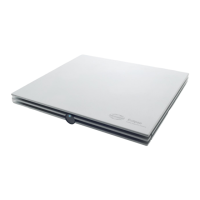Eclipse Additional Information Page 212
10.4 FAQ – ASSR
Q: How is the stimulus calibrated?
A: The 90Hz ASSR stimulus is calibrated in nHL. The 0dB nHL calibration level was found by testing 10
normal hearing young subjects - 20 ears - for their psychoacoustic thresholds to each of the four stim-
ulus frequencies presented independently, monaurally.
The 40Hz stimulus calibration is based on the above calibration values but modified for the different
stimulus rate according to ISO 389-6.
Q: What is the polarity, the filter settings and the episode length of the different NB CE-Chirp stim-
ulus?
A: The ASSR stimuli are alternating, this will ensure that no CM can be recorded and be a subject for a
false pass. There are no filter applied to the ASSR stimuli, except from the DC filter at .05Hz and anti-
aliasing filter at 5kHz.The length of the NB Stimuli are different for each frequency
4kHz: 1.5ms
2kHz: 2.5ms
1kHz: 3.5ms
500Hz: 4.5ms
Q: Even though the EEG waveform is quite small, it is red raw EEG and it is rejecting.
A: The EEG may hold spikes that do not show on the screen but are causing the rejection.
Look for the causes of disturbance and minimize them if possible. This typically involves checking the
integrity of the electrodes and maximizing patient relaxation. Increase the rejection level by the control
located between the L and R EEG displays only if unavoidable but note that allowing interference into
the system is likely to degrade the accuracy of results.
Q: I sometimes have a pass at maybe 40dB and 60dB but none at 50dB?
A: It is not unusual that a run does not produce a response even though lower intensities may. You may
repeat the intensity in question or just disregard the occurrence and assure yourself that the lower in-
tensity pass is a real pass (repeat it or see if even lower intensities pass). The result at 50dB may be
valid so accept passes at lower intensities only if they can be repeated.
Q: I am testing with electrodes on my arm. I have found passes in this situation.
A: Yes that is possible. The “Test Method Priority” setting in the setup chooses the risk of obtaining this:
The “Speed” setting gives a 5% risk and the “Accuracy” setting gives a 1% risk.
These figures rely on the type of EEG produced at normal electrode positioning. Results obtained at
the arm or other sites are not a relevant test of specificity.
Please also see other documentation for the Interacoustics ASSR system dealing with this issue.
Q: I am testing without any acoustic stimulation. I have found passes in this situation.
A: Yes that is possible. The “Test Method Priority” setting in the setup chooses the risk of obtaining this:
The “Speed” setting gives a 5% risk and the “Accuracy” setting gives a 1% risk.
Q: What is meant by “EEG Too low” displayed on the screen?
A: In order for the algorithm to operate correctly, a minimum EEG level needs to be present. If this mini-
mum level is not present, this message will be displayed. It is typically the case when the Preamplifier
is left in Impedance Test mode.
Q: I have found that in a session, I can get a ”no response” at e.g. 50dB, but later in the session I
can get responses at lower intensities – why?
A: More than likely, it is because the patient during the session became more and more relaxed which
generates lower and lower EEG/Noise. Under this condition, a response can be found where it was
buried in noise earlier in the session. This is a good example of the importance of having a very re-
laxed – low EEG – patient state from the beginning of the test. However the pass at a lower level may
be erroneous and should be accepted only if a repeat also gives a pass result.

